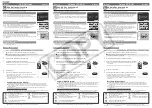
50
Copyright © Acronis, Inc., 2000-2010
Backup to a locally attached tape device
When creating a backup plan, you are able to select the locally attached tape device as the backup
destination. An archive name is not needed when backing up to a tape.
An archive can span multiple tapes but can contain only one full backup and an unlimited number of
incremental backups. Every time you create a full backup, you start with a new tape and create a
new archive. As soon as the tape is full, a dialog window with a request to insert a new tape will
appear.
The content of a non-empty tape will be overwritten on prompt. You have an option to disable
prompts, see Additional settings (p. 119).
Workaround
In case you want to keep more than one archive on the tape, for example, back up volume C and
volume D separately, choose incremental backup mode instead of a full backup when you create
an initial backup of the second volume. In other situations, incremental backup is used for
appending changes to the previously created archive.
You might experience short pauses that are required to rewind the tape. Low-quality or old tape, as
well as dirt on the magnetic head, might lead to pauses that can last up to several minutes.
Limitations
1.
Multiple full backups within one archive are not supported.
2.
Individual files cannot be recovered from a disk backup.
3.
Backups cannot be deleted from a tape either manually or automatically during cleanup.
Retention rules and backup schemes that use automatic cleanup (GFS, Tower of Hanoi) are
disabled in the GUI when backing up to a locally attached tape.
4.
Personal vaults cannot be created on tape devices.
5.
Because the presence of an operating system cannot be detected in a backup located on a tape,
Acronis Universal Restore (p. 409) is proposed at every disk or volume recovery, even when
recovering a Linux or non-system Windows volume.
6.
Acronis Active Restore (p. 397) is not available when recovering from a tape.
Recovery from a locally attached tape device
Before creating a recovery task, insert or mount the tape containing the backup you need to recover.
When creating a recovery task, select the tape device from the list of available locations and then
select the backup. After recovery is started, you will be prompted for other tapes if the tapes are
needed for recovery.
2.12
Support for SNMP
SNMP objects
Acronis Backup & Recovery 10 provides the following Simple Network Management Protocol (SNMP)
objects to SNMP management applications:
Type of event
Object identifier (OID): 1.3.6.1.4.1.24769.100.200.1.0
Syntax: OctetString
















































